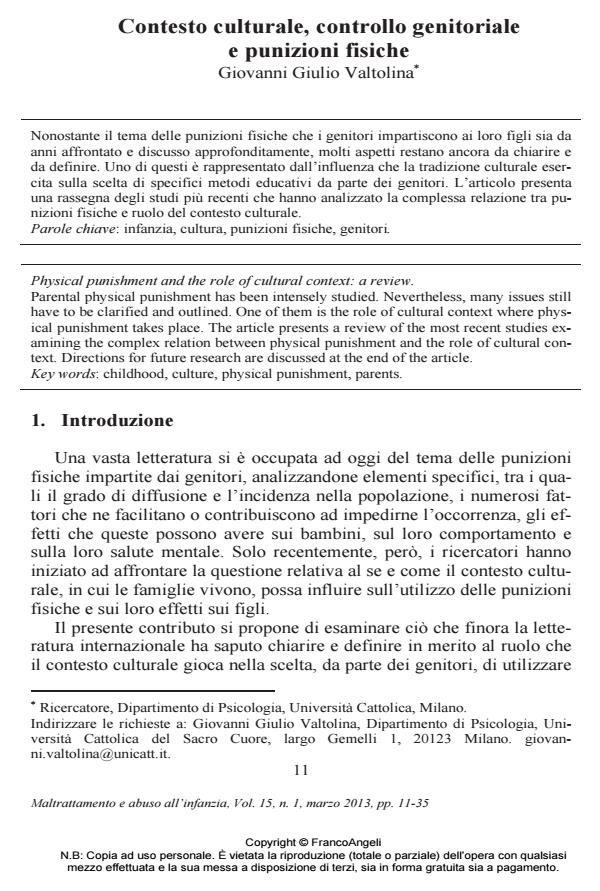Contesto culturale, controllo genitoriale e punizioni fisiche
Titolo Rivista MALTRATTAMENTO E ABUSO ALL’INFANZIA
Autori/Curatori Giovanni Giulio Valtolina
Anno di pubblicazione 2013 Fascicolo 2013/1
Lingua Italiano Numero pagine 35 P. 11-25 Dimensione file 710 KB
DOI 10.3280/MAL2013-001002
Il DOI è il codice a barre della proprietà intellettuale: per saperne di più
clicca qui
Qui sotto puoi vedere in anteprima la prima pagina di questo articolo.
Se questo articolo ti interessa, lo puoi acquistare (e scaricare in formato pdf) seguendo le facili indicazioni per acquistare il download credit. Acquista Download Credits per scaricare questo Articolo in formato PDF

FrancoAngeli è membro della Publishers International Linking Association, Inc (PILA)associazione indipendente e non profit per facilitare (attraverso i servizi tecnologici implementati da CrossRef.org) l’accesso degli studiosi ai contenuti digitali nelle pubblicazioni professionali e scientifiche
Nonostante il tema delle punizioni fisiche che i genitori impartiscono ai loro figli sia da anni affrontato e discusso approfonditamente, molti aspetti restano ancora da chiarire e da definire. Uno di questi è rappresentato dall’influenza che la tradizione culturale esercita sulla scelta di specifici metodi educativi da parte dei genitori. L’articolo presenta una rassegna degli studi più recenti che hanno analizzato la complessa relazione tra punizioni fisiche e ruolo del contesto culturale.
Parole chiave:Infanzia, cultura, punizioni fisiche, genitori
- Children and Peace Luca Milani, Sarah Miragoli, Serena Grumi, Paola Di Blasio, pp.3 (ISBN:978-3-030-22175-1)
- Risk assessment in a multicultural context: Risk and protective factors in the decision to place children in foster care Serena Grumi, Luca Milani, Paola Di Blasio, in Children and Youth Services Review /2017 pp.69
DOI: 10.1016/j.childyouth.2017.04.009 - Parental psychological control: An intrusive form of parenting Rosalba Larcan, in MALTRATTAMENTO E ABUSO ALL'INFANZIA 2/2020 pp.7
DOI: 10.3280/MAL2020-002001 - Improving the Early Assessment of Child Neglect Signs—A New Technique for Professionals Giovanni Valtolina, Concetta Polizzi, Giovanna Perricone, in Pediatric Reports /2023 pp.390
DOI: 10.3390/pediatric15020035 - L'approccio interculturale nel contrasto alla violenza sui minori con background migratorio Mariagrazia Foschino Barbaro, Giovanni Giulio Valtolina, in MALTRATTAMENTO E ABUSO ALL'INFANZIA 2/2024 pp.49
DOI: 10.3280/MAL2024-002004 - La famiglia omogenitoriale oggi: pregiudizio per lo sviluppo del minore? Un'analisi della letteratura dal 2000 al 2015 Giuseppe Mannino, Marta Schiera, in MALTRATTAMENTO E ABUSO ALL'INFANZIA 3/2017 pp.87
DOI: 10.3280/MAL2017-003006 - Risk and Protective Factors regarding Child Neglect: Differences among Immigrant and Italian Parents Francesca Ranghetti, Luca Milani, in Journal of Aggression, Maltreatment & Trauma /2022 pp.44
DOI: 10.1080/10926771.2021.1970671
Giovanni Giulio Valtolina, Contesto culturale, controllo genitoriale e punizioni fisiche in "MALTRATTAMENTO E ABUSO ALL’INFANZIA" 1/2013, pp 11-25, DOI: 10.3280/MAL2013-001002